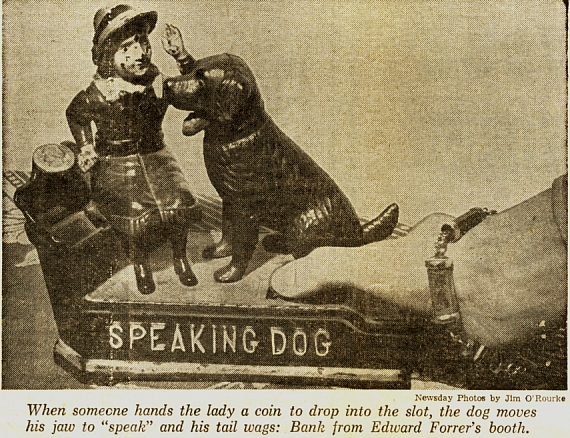Newsday, Tuesday, February 9, 1971, page 15A
LI antique show banks on spenders
By Doris Herzig Even in the days when a penny saved was a penny earned, you had to have a gimmick to get people to save. Banking institutions weren't giving away hair dryers and electric knives to attract new accounts, but mechanical banks with all sorts of ingenious, pre-Rube Goldberg devices were tempting children to deposit their coins. Now these iron mechanical banks of the late 19th Century are among the collectors' items that are tempting adults to deposit their dollars at the eighth annual IHB Long Island Antiques Fair and Sale in the Garden City Hotel. The show, sponsored by the Garden City League of the Industrial Home for the Blind, will be open today until 10 PM and tomorrow from noon to 9 PM. Proceeds from the $1.50 admission will help finance a new rehabilitation center in New Hyde Park. Edward E. Forrer's exhibit includes a shelf full of mechanical banks, which gobble up money in a variety of complicated ways. There is nothing so simple as putting a coin in a slot. (What child wouldn't rather buy candy than do that?) There's one bank called "Speaking Dog" in which a woman is holding a paddle. You put the penny on the paddle. When you press a lever, she drops the money into a bin and the dog beside her opens and closes his mouth and wags his tail. This is priced $175. If you have $375 worth of pennies for "Jonah and the Whale," you might put one of them on Jonah's head. As a man in a rowboat feeds him to a big-mouthed whale, the coin goes down too, to be retrieved on a rainy day. Whether the dealer or the buyer gets rich on such purchases is a moot point. Prices at the show seemed much lower than those in New York shows and shops, and dealers claim that antiques are good investments which can be used and enjoyed while their value rises. Glassware, silverware, dolls and clocks abound at the show, and while there's a minimum of art deco, the wares of the 1920s and 1930s that have become the latest vogue among collectors, there are some items in this category. Minna Rosenblatts' art glass display, for example, includes a number of French vases with the repetitive patterns of the period, including a cameo-cut vase with a blue motif over red glass, at $225. Cut glass, pressed glass, milk glass and cranberry glass are more widely represented. Doxey and McCarthy, for example, is showing an array of pre-Civil War flint goblets ranging from $12 to $40. The variety of traditional patterns include the New England Pineapple, Ashburton and Eugenie motifs. Pattern, on the other hand, is the least of Eleanor Mulligan's concerns. "I don't know the pattern and I don't care as long as they're heavy, deep-cut and brilliant," said Miss Mulligan pointing to a sparkling, $475 cut-glass salad set consisting of a bowl, dish and glass-handled spoon. While the current wave of nostalgia for the '20s is not engulfing this show, it is leaving a few deposits. At Boehme and Kaplan, where a pale-yellow fluted container of "vaseline glass" ($17.50) contrasted with a pair of green-footed cranberry glass compotes ($22.50 each), there is also an art-deco hatpin holder in yellow, green and orange pottery for $9.75. And at Grace Dyae's doll-filled booth, a 125-year-old French porcelain fashion doll with paperweight-eyes is the center of attention at $1,200. But she has to compete with a much younger, flirty-eyed bisque kewpie doll ("only 50-ish," Miss Dayer said) priced at a comparatively modest $75. Even avid antiques-hunters will find it hard to lose track of time, for there's hardly a booth without an old clock. Mrs. Irene Christensen of Garden City is showing an array of wall clocks, including an octagonal English model (with American works), made of papier-mache with mother-of-pearl inlay at $185. "People are always looking for good antique clocks," said Martin Fleisher, who brought 27 old timepieces from Reading, Pa., but doesn't have room for all in his booth. He managed, however, to find a place for a 1739 grandfather clock made in York, England, by William Coulton ($950), and a group of wall clocks, French, Viennese, English with American works and French with German works, tagged from $160 to $185. The prize specimen at Norman Litman's booth is a tall case clock (the connoisseur's term for a grandfather clock) made by Elnathan Taber of Roxbury, Mass., around 1810 and sold to a shipbuilder for $65 (the sum is inked inside the case cover). Litman wants $8,500 for the clock, which has a cherry-wood case and a revolving dial which shows a moon face, a landscape and a ship. But the tallest clock at the show (more than eight feet tall) towers over Lisl Antiques. It was made by Tiffany & Co. and is inlaid with a variety of woods. The buyer would have to have a home with a high ceiling and $7,500. Caption under lead photo: When someone hands the lady a coin to drop into the slot, the dog moves his jaw to "speak" and his tail wags: Bank from Edward Forrer's booth. Newsday Photos by Jim O'Rourke |
